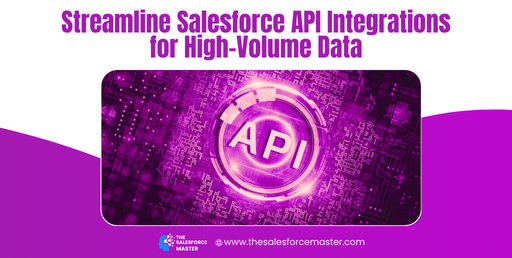
Streamlining Salesforce API Integrations for High-Volume Data
Efficient Salesforce API integrations are essential for managing large datasets and maintaining seamless operations. For Salesforce Marketers, optimizing these integrations ensures data flows smoothly across systems, enhancing customer insights and campaign efficiency. Let’s explore key strategies for handling high-volume data while ensuring robust performance.
Optimize API Call Efficiency
Managing high data volumes requires minimizing API call usage. Use bulk APIs and batch processing to reduce individual calls. Salesforce provides the Bulk API 2.0, which is ideal for processing large datasets asynchronously. This feature helps Salesforce Marketers import and export data efficiently without impacting system performance. Additionally, use Composite APIs to group multiple requests into a single call, reducing overhead.
Properly implementing caching mechanisms can significantly improve integration performance. By caching frequently accessed data, you reduce redundant API calls. Integrate with Salesforce Login securely and maintain optimal session management to avoid unnecessary token renewals.

Leverage Data Chunking and Pagination
For large data transfers, it’s crucial to break down datasets into manageable chunks. Implement pagination when retrieving data via Salesforce REST or SOAP APIs. This practice ensures your system processes data gradually, preventing timeouts or resource overloads.
Salesforce Marketers benefit from data chunking as it allows smoother customer segmentation and reporting. Using query locators, such as in SOQL, helps retrieve large datasets in smaller, controllable batches. Always handle timeouts and retries gracefully to avoid failed integrations.
Monitor and Scale API Usage
Regular monitoring of API usage ensures you stay within Salesforce API limits. Use the Salesforce API Usage Report to track consumption and identify potential bottlenecks. Implement adaptive rate limiting to dynamically control API requests based on system load.
Scaling involves optimizing both horizontal and vertical system architecture. For high-traffic integrations, consider load balancing and distributing requests across multiple instances. Salesforce Marketers can utilize Marketing Cloud for managing large campaign datasets, ensuring smooth execution.
Logging plays a key role in tracking API performance. Implement detailed logging to capture request/response data and identify issues quickly. This visibility helps optimize integrations continuously, reducing downtime and enhancing reliability.
Key Takeaways for Salesforce Marketers:
- Minimize API Calls: Use bulk and composite APIs to handle large data volumes efficiently.
- Optimize Data Flow: Implement chunking and pagination for smoother data transfers.
- Monitor and Scale: Track API usage and employ adaptive scaling to ensure robust performance.
Efficient Salesforce API integrations empower marketers to handle high-volume data seamlessly. By optimizing calls, leveraging data chunking, and monitoring usage, Salesforce Marketers can enhance their workflows and drive data-driven decisions effectively. Integrating these best practices ensures your system remains scalable and reliable, delivering superior customer engagement.



